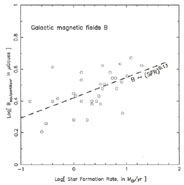


4.2.1. Observed weak relationship of B with SF
On the observational side, early statistics done for 8 spiral galaxies with an observed galactic Star Formation Efficiency (SFE) and an observed galactic magnetic field strength (Breg) obtained via Faraday Rotation, indicated that an increase in SFE value did not result in a noticeable increase or decrease in B value (e.g., Table 3 in Vallée 1992). Rather, B2 remained roughly constant with SFE, within the errors involved.
Later, published homogeneously-calibrated magnetic field data obtained from a complete sample of galaxies were used. The complete sample refers to all the late-type galaxies which are optically brighter than BT = 12 mag and whose Declination is above +10° (Fitt & Alexander, 1993). The homogeneous calibration refers to observations with the same telescope and data reduction procedure (VLA-C/D at 1.49 GHz). Recent statistics on these data showed a possible link between B and star formation SF. For 33 nearby galaxies, with both a measured equipartition magnetic field (= Btot, from synchrotron emission) and an observed star formation rate (SFR), Vallée (1994b) found a law of the form: Btot = Beq = 2.6 µGauss (SFRsolar mass / year)j, with j = 0.13 ± 0.04.
Figure 12 shows the run of
Beq as a function of SFR, in 33
nearby normal spiral galaxies. The correlation is weak but real
at the 3 r.m.s. level, with a linear correlation coefficient
r = 0.55. Here the SFR was defined by
Kennicutt (1983;
1998)
as the ratio: H luminosity (at 0.66 µm) / 1.2 × 1041 erg
s-1, and expressed in units of
M
luminosity (at 0.66 µm) / 1.2 × 1041 erg
s-1, and expressed in units of
M yr-1. Also, Beq was determined by
Fitt and Alexander
(1993),
using minimum energy conditions in a synchrotron plasma in a thin disk
(0.6 kpc), emitting between 10 MHz and 100 GHz with a spectral
index of -0.75, unity filling
factor, and k = 0 for the electron/proton energy ratio.
yr-1. Also, Beq was determined by
Fitt and Alexander
(1993),
using minimum energy conditions in a synchrotron plasma in a thin disk
(0.6 kpc), emitting between 10 MHz and 100 GHz with a spectral
index of -0.75, unity filling
factor, and k = 0 for the electron/proton energy ratio.
 |
Figure 12. A correlation between the
galactic magnetic field (Btot) and the
star formation rate (SFR), in 33 nearby spiral galaxies. The lsf
line is shown, yielding the law:
Beq = 2.6[SFR]0.13, where
Beq is in µG and SFR is in
M |
Such a direct relation is weak, not strong, contrary to some theoretical predictions. Thus Ko and Parker (1989) had predicted that, when the SFE is high, the interstellar medium is churned and in turns it amplifies the galactic magnetic field B. Chi and Wolfendale (1993) proposed a larger magnetic field strength B when the SFR is high.
For 48 nearby spiral galaxies in the complete sample, and
both a measured equipartition magnetic field and an observed star formation
efficiency (SFE),
Vallée (1994b)
found a relationship as follows:
Btot = Beq = 2.7 µGauss
(SFEsolar lumin / solar mass)j , with
j = 0.13 ± 0.04. Here the SFE was defined by
Young et al. (1986)
as the ratio: Infrared
Luminosity (40 µm - 300 µm) / molecular hydrogen
mass, and expressed in units of
L /
M
/
M .
.
These two findings indicate that there is a weak correlation between B and star formation SF, independently for 33 and for 48 nearby galaxies mostly located in the Virgo Supercluster of galaxies. Kamaya (1996) has employed this weak correlation between interstellar magnetic fields and star formation rate. Future trends: it would be nice to study magnetic fields versus star formation in specific cases of late- type galaxies, notably in 'starburst' galaxies, as well as in 'disturbed' galaxies.
Some authors have predicted a stronger theoretical relation
B ~ SFRj, with
j  3, based
on a derivation of a relation
B ~ nk for intercloud B outside
clouds and for thermal gas
inside clouds - this is not appropriate for galactic-wide density
and galactic-wide magnetic
field values since B outside clouds and n outside clouds should
be used (see e.g., Section 4.2.4).
3, based
on a derivation of a relation
B ~ nk for intercloud B outside
clouds and for thermal gas
inside clouds - this is not appropriate for galactic-wide density
and galactic-wide magnetic
field values since B outside clouds and n outside clouds should
be used (see e.g., Section 4.2.4).